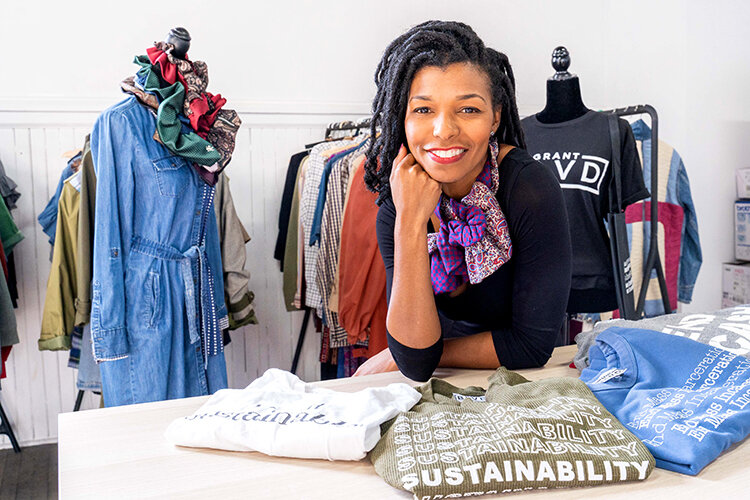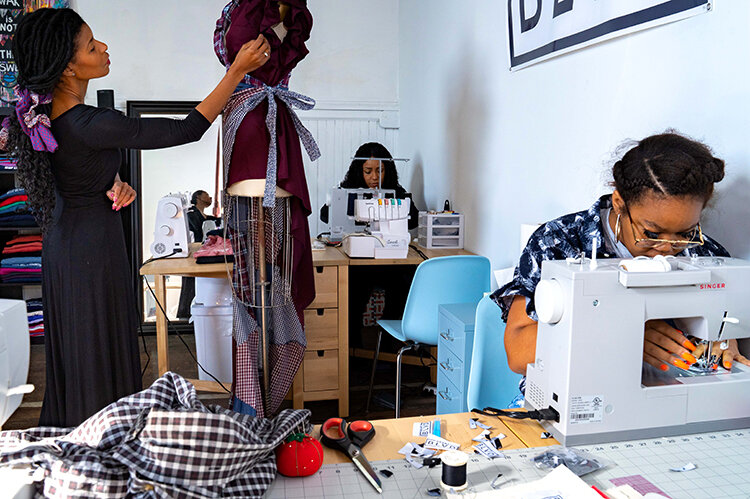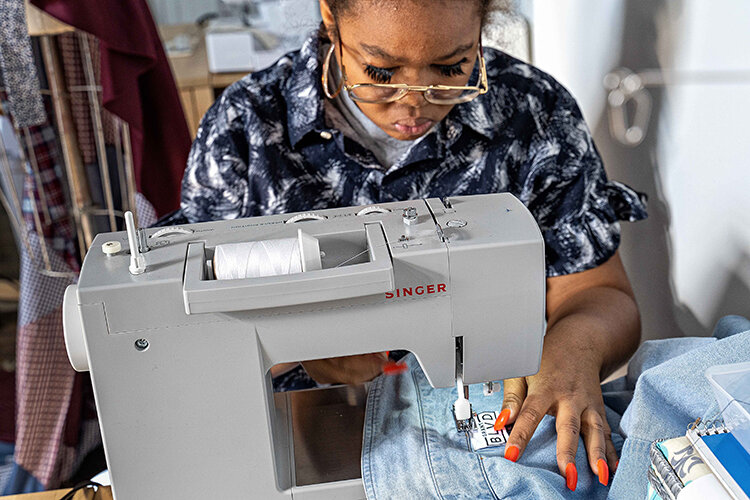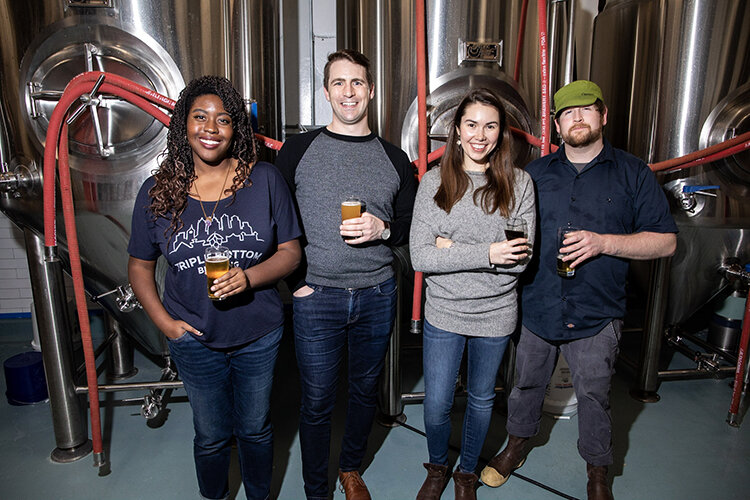Kimberly McGlonn is the founder of Grant Blvd. The slow-fashion company is based in Grays Ferry. | Photography by Milton Lindsay
By Claire Marie Porter
Grant Blvd is the name of the street where Kimberly McGlonn grew up in Milwaukee, on the North side, “where the blacks lived,” she says. She has no background in fashion, aside from her mother dragging her through thrift stores as a child.
“I hated them,” she remembers, “the dust, the chaos.”
These were defining moments for her, however, as she describes this time in her past as the beginning of her “lifelong training” to return life to something others have thrown away, both literally and metaphorically.
On Grant Blvd, she was exposed early to a variety of themes about beauty, health, clothing and poverty that would later inform her business, and manifest in a company that combats climate change and fast fashion while giving hope to previously incarcerated individuals.
McGlonn, a petite 40-year-old woman whose zest for life is visible, is a Doctor of Philosophy and teacher of social justice in the Lower Moreland school district, a councilwoman for her community in Jenkintown, and the CEO and founder of Grant Blvd, a radical fashion design company that is deconstructing stereotypes while attempting to disrupt systems and protect the Earth.
Now, in a modest, naturally lit studio on the second floor of the Queen Memorial Building in Grays Ferry, McGlonn has created a new vision of Grant Blvd. It’s a place of refuge, free from waste and free from judgement, a sanctuary where people from all walks of life make beautiful things together.
The styles are fashioned from salvaged clothing handpicked in local thrift stores. From sweatshirts and tees to runway styles, the company uses no new water and barely any new materials, and zero outsourcing. The small Grant Blvd team designs, cuts and sews every piece of clothing in its collection.
Grant Blvd’s mission is to directly battle systemic problems like climate change and mass incarceration but also to whittle away at capitalism and subvert the patriarchy. Because as McGlonn points out, a truly sustainable business isn’t just about being “eco-friendly,” it’s about rebuilding community, fostering a safe space, having a holistic approach to employment and, if it’s Grant Blvd, creating edgy, bold and idiosyncratic garments.
“Some people don’t want their fashion to be political,” she says. “That’s not my tribe.”
>
“Some people don’t want their fashion to be political. That’s not my tribe.”
Fast fashion is a modern invention. While the traditional fashion cycle was twice a year, spring and summer and fall and winter, the trends are on a super speed cycle and have as many as 50 to 100 microseasons.
What that means is consumers are purchasing more clothing, more quickly, and keeping older items for shorter periods of time. According to the World Resources Institute, the average consumer bought 60 percent more clothing in 2014 than in 2000 and kept each garment for half as long.
The turnover is only part of the problem. Cotton is an incredible thirsty plant, and the main one used in clothing production, making up about 33 percent of all fibers.
Clothing already has an enormous carbon footprint; the fashion cycles’ planned obsolescence only exacerbates the problem.
Grant Blvd is combating its carbon footprint both subversively and noisily. Screen printing is one way that it uses fashion to start conversations, says McGlonn.
“Sustainable AF,” and “Earth Bae” are some of the messages on Grant Blvd’s screen-printed styles that suggest the sentiment “that we are people who have a really affectionate relationship with the planet,” says McGlonn.
“Books, not bars” promotes public education over prisons, and “End mass incarceration,” the most popular print, addresses the overcrowding and poor treatment of people who are incarcerated.
“What we wear should communicate our values,” she says.
And everything we choose to put on our bodies makes a statement, even if it does so silently, she points out. But for those that want to be a little more vocal, it can also be a conversation piece, she adds.
On display in McGlonn’s studio is a vintage men’s military coat, reminiscent of the original structure, but reshaped and with added color and ruching, a bunching technique used in dressmaking that gives fabric a three-dimensional quality.
Another piece is a long, architectural skirt made from denim scraps, with a matching denim jacket that sports a denim-scrap mosaic of the Earth on the back.
“We don’t throw away,” she says. “We don’t waste anything.”
A vintage trench coat with pillow cases lining the back is both practical and fresh, like a walking quilt. Another piece is a dusty rose vintage coat that McGlonn paired with curtain sheers, giving it puffy, voluminous sleeves.
The Harriet, a classic men’s button-up shirt reworked with a feminine crop and ruffled sleeve, is another favorite, and a mainstay in the collection.
At a recent fashion show, the showstopper was an evening gown fashioned from men’s business shirts.
“It still has life,” says McGlonn. “We just have to find it and make it and give it.”
As several employees work on implementation, McGlonn styles a new garment. All of Grant Blvd’s clothing is crafted from second hand wares. | Photography by Milton Lindsay
McGlonn’s vision to fight mass incarceration and inhabit the intersection between sustainability and social justice is manifested in both the items of clothing and her approach to “green collar” job creation.
In order to focus on employing previously incarcerated and returning citizens, she’s created partnerships throughout the city and a fellowship program to help identify women who are interested in sewing, who have had some life experience with the criminal justice system.
The employment is holistic: along with being taught to sew, healthy habits and diet are also a part of the training.
Her current team consists of two interns, a director of talent and development, a director of production and design, and she is working on bringing on a director of operations.
Grant Blvd currently employs one formerly incarcerated woman as a seamstress, a product of the fellowship program. The company recently partnered with the Pennsylvania Department of Corrections to identify new talent, which will include re-entered citizens as well as those preparing to re-enter in Philadelphia County. The idea, says McGlonn, is to build a bridge from their current situation to a steady vocation when they’re out of the prison system, so they can have a community waiting for them.
“We’ll make visits into correctional facilities, and build networks in that direction, and then create a nice, warm, soft landing spot,” says McGlonn.
Because 95 percent of incarcerated people do come home, says McGlonn. Six hundred and fifty thousand people in the United States return home from prison every year, according to the American Civil Liberties Union.
Women are also the fastest growing incarcerated population in the country. Mass incarceration refers to the singular way the United States has dealt with crime, leading to a staggering number of prisoners. Currently, the U.S. holds 25 percent of the world’s prison population, having increased 700 percent since 1970, largely as a result of the War on Drugs. These numbers include local, federal and state prisons.
A significant part of Grant Blvd’s training program is recognizing that prison is a traumatic experience, and coming home has many obstacles to reintegration, says McGlonn.
It requires “business planning that is mindful of avoiding exploitation and adding nutrition to the lives of people who have experienced cyclical trauma and generational poverty,” says McGlonn.
Nevada Gray, Grant Blvd’s director of production and design, says that before working with McGlonn, she was so accustomed to working with fast fashion and new materials that she had never once thought about the waste.
“I’m super new to sustainable fashion,” she says. “And it’s really changing my life. How I shop, how I think—I can’t stop talking about it.”
“If I have become passionate about this,” says Gray, “anyone can.”
Gray studied fashion design at the Art Institute of Philadelphia, specializing in formal wear. The creativity that goes with restricted fabric supply has challenged her ideas of what can be done with less. She also says the environment at Grant Blvd is very open and honest.
It’s a breeding ground for creativity.
Together she and McGlonn handpick garments and scraps that are in good condition. Along one wall in the studio are piles of thrifted menswear, mostly flannel shirts.
Some of that creativity includes taking used garments and reimagining them.
“We play with taking back things that once belonged to men,” says McGlonn, and about 75 percent of the salvaged materials were previously menswear, she says. Because the sizes are often larger, there’s more room for cutting and restructuring, and ability to cater to all body shapes and sizes.
“I completely love the play of the pulling out the effeminate in the masculine,” says Gray. “We’re not these fragile little flowers. I love that in our story.”
As the director of design, every garment goes through Gray’s hands before it leaves the studio, she says. She oversees all the sewing and works one on one with all of the employees. She says the production is slow, because many women who go through the training program have little to no prior experience.
In perfecting small things, like doing labels or working on a specific stitch, Grant Blvd revels in the small triumphs, she explains.
“It’s amazing to go to work and feel like you’re making some impact in the world,” she says.
A Grant Blvd seamstress stitches a label into a denim jacket. The company currently has four employees. | Photography by Milton Lindsay
It was McGlonn’s upbringing that led her to work that addresses the needs of the marginalized. Her father was a food activist who opened up a healthy deli across the street from a Kentucky Fried Chicken. Her mother volunteered at a correctional institute on the weekends.
“That was the backdrop in my parents’ lives,” she says. “That informed my activism.”
She went on to become a teacher for the next 18 years. But as she struggled to teach her high school students about the complexities of the U.S. criminal justice system, as well as the state of the planet, she found herself feeling disconnected.
She spent a year learning about the fashion industry and working in the prison industrial system. She started volunteering for Books through Bars (where the screen-print inspiration came from), a volunteer-run program in Philadelphia that distributes free books and other educational materials to people who are incarcerated. For every Grant Blvd garment purchased, the company sends a book through the program.
Two years ago she resigned from teaching full-time, though she still teaches high school classes in Montgomery County. She also works with twelfth graders who need extra support.
McGlonn puts about 35 hours a week into Grant Blvd, handling all the marketing, publicity and sales, going straight from her teaching job to her studio.
She works long days, but it’s so much soul work, she says, she doesn’t mind.
Too often, the modern sustainability movement excludes marginalized communities. The first four United Nations’ sustainable development goals—eradicating poverty and food insecurity, while promoting good health and quality education—address inequality. Yet sustainability can be a buzzword for eco-friendly trends that do not exact change for those who are most impacted by the changing climate and inequality.
“As America becomes less white, we’ve gotta get that majority to the table,” says McGlonn.
The conversation must include the marginalized, and it needs to be in a way that recognizes not just equality, but ownership, she continues.
And it’s more than just Fair Chance hiring, she adds, it’s about getting them to a place of self-sufficiency.
“People who come home from prison, they need opportunities, and if we don’t create them, they don’t exist,” she explains.
She wants to urge sustainable businesses to think about how to create communities where people who have been purposefully marginalized are brought to the spotlight.
“Until we can shift the sustainability conversation to include people of color, it will be an effort in vain,” says McGlonn.
The brand aims to launch into a retail space by next year, and then to encourage a conversation about sustainability that is accessible for people at a variety of price points, and highly inclusive, she says.
“The hope is to use retail … to challenge systems of hierarchy,” she says, “while wearing our values.”
Being intentional about not only what we buy, but from whom we buy, holds a lot of weight, says McGlonn.
By doing so, “we have the power to challenge not only the social issues exacerbated by mass incarceration, but to more meaningfully address climate change,” she says.
“Because if it’s not for the good of the whole,” she says, “then it really ain’t good.”












